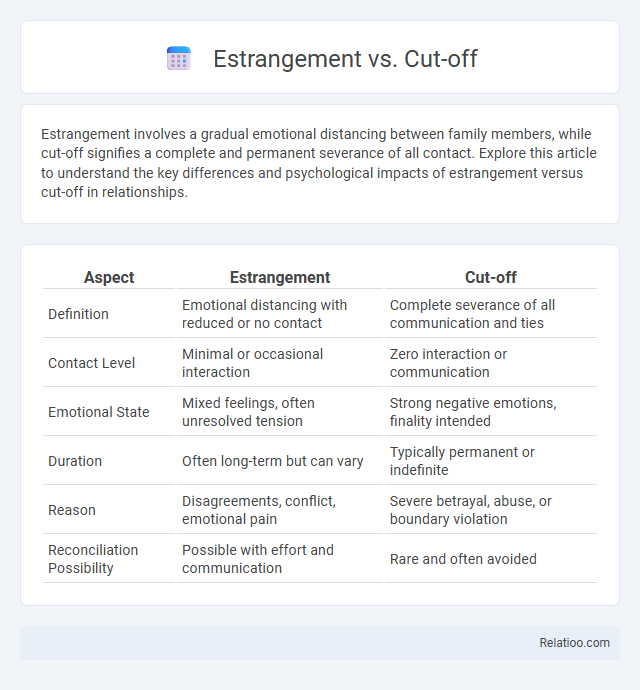Estrangement involves a gradual emotional distancing between family members, while cut-off signifies a complete and permanent severance of all contact. Explore this article to understand the key differences and psychological impacts of estrangement versus cut-off in relationships.
Table of Comparison
| Aspect | Estrangement | Cut-off |
|---|---|---|
| Definition | Emotional distancing with reduced or no contact | Complete severance of all communication and ties |
| Contact Level | Minimal or occasional interaction | Zero interaction or communication |
| Emotional State | Mixed feelings, often unresolved tension | Strong negative emotions, finality intended |
| Duration | Often long-term but can vary | Typically permanent or indefinite |
| Reason | Disagreements, conflict, emotional pain | Severe betrayal, abuse, or boundary violation |
| Reconciliation Possibility | Possible with effort and communication | Rare and often avoided |
Understanding Estrangement: A Brief Overview
Estrangement involves a significant emotional or physical distance between individuals, often within families, due to unresolved conflicts or deep-seated issues. Cut-off represents the complete or near-complete cessation of communication and interaction, marking the most extreme form of estrangement. Understanding estrangement requires recognizing the varying degrees of separation and the underlying causes that drive individuals to reduce or end contact, which can include trauma, betrayal, or conflicting values.
Defining Cut-Off: What Does It Mean?
Cut-off refers to the complete and intentional severing of all communication and contact between individuals, often seen as a more extreme form of estrangement. Unlike general estrangement, which may involve emotional distance or infrequent interaction, cut-off involves a deliberate decision to end all ties permanently or for an extended period. Understanding cut-off helps you navigate complex family dynamics by recognizing when boundaries have been firmly established.
Key Differences Between Estrangement and Cut-Off
Estrangement involves a prolonged period of emotional distance or lack of communication between individuals, often due to unresolved conflicts or personal differences, whereas a cut-off is a deliberate and complete severance of all contact, typically as a protective measure against toxicity or harm. Your ability to recognize these distinctions can guide appropriate responses or reconciliation efforts. Estrangement may leave room for eventual repair, while a cut-off signifies a more definitive and urgent boundary.
Common Causes of Estrangement and Cut-Off
Common causes of estrangement and cut-off often involve unresolved conflicts, boundary violations, and deep-seated emotional wounds arising from betrayal or neglect. Family dynamics marked by persistent criticism, control issues, or lack of empathy contribute significantly to both estrangement and cut-off situations. Traumatic events or repeated patterns of abuse intensify alienation, making reconciliation challenging without professional intervention.
Emotional Impact on Individuals and Families
Estrangement refers to a gradual emotional distancing between family members marked by unresolved conflicts, often leading to feelings of sadness and loss. Cut-off involves a complete and intentional severance of contact, causing profound emotional pain and a sense of abandonment for both parties. Both estrangement and cut-off significantly affect individuals' mental health, increasing risks of depression and anxiety, while families experience fractured relationships and complex dynamics of guilt and grief.
Signs and Stages of Relationship Distancing
Signs of estrangement include persistent communication breakdown, emotional withdrawal, and avoidance of contact, while cut-off is marked by a deliberate and complete severance of all ties, often accompanied by clear boundaries and no interaction. Stages of relationship distancing progress from subtle indifference and decreased engagement, to overt conflict and exclusion, eventually culminating in estrangement or cut-off. Understanding these stages helps you recognize early warning signs and address underlying issues before relationships become irreparable.
Communication Patterns in Estrangement vs Cut-Off
Communication patterns in estrangement typically involve intermittent or strained contact, where misunderstandings and unresolved conflicts persist without total severance. Cut-off represents a complete cessation of communication, reflecting a boundary or self-protection mechanism that ends all interaction between parties. Your ability to recognize these distinct patterns helps in addressing relational dynamics and determining appropriate steps toward resolution or acceptance.
Reconciliation: Is It Possible?
Estrangement involves emotional distance without complete severance, while cut-off represents total disconnection from a family member. Reconciliation often depends on mutual willingness to address past conflicts, with estrangement offering more opportunities for dialogue than cut-off. Your ability to heal relationships hinges on understanding these distinctions and fostering open communication.
Coping Strategies for Affected Individuals
Coping strategies for individuals dealing with estrangement involve setting healthy boundaries, seeking therapy, and cultivating supportive social networks to process emotional trauma. In cut-off situations, maintaining self-care routines and engaging in mindfulness or stress-reduction techniques help mitigate feelings of loss and isolation. For long-term estrangement, building resilience through professional counseling, peer support groups, and focusing on personal growth fosters emotional healing and acceptance.
Resources for Support and Healing
Estrangement, cut-off, and general estrangement involve different levels of relationship distance requiring tailored approaches for support and healing. Resources such as family therapy, support groups, and individual counseling can provide specialized strategies to navigate emotional boundaries and rebuild trust. You can access online platforms, books, and community workshops designed specifically to facilitate understanding and recovery from relational separation.

Infographic: Estrangement vs Cut-off
 relatioo.com
relatioo.com